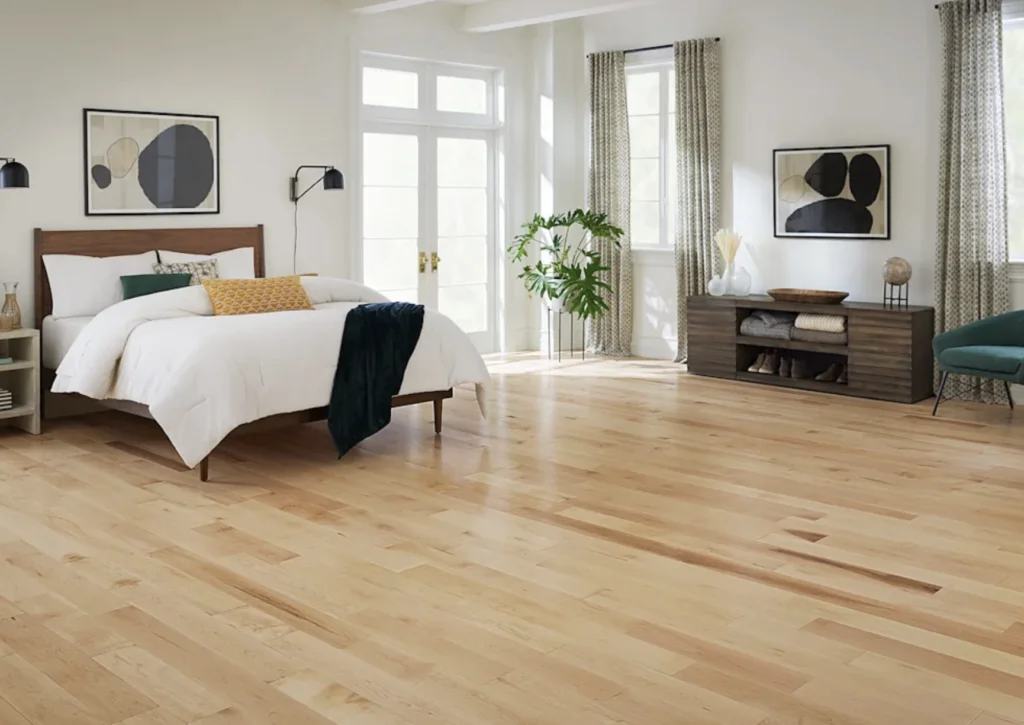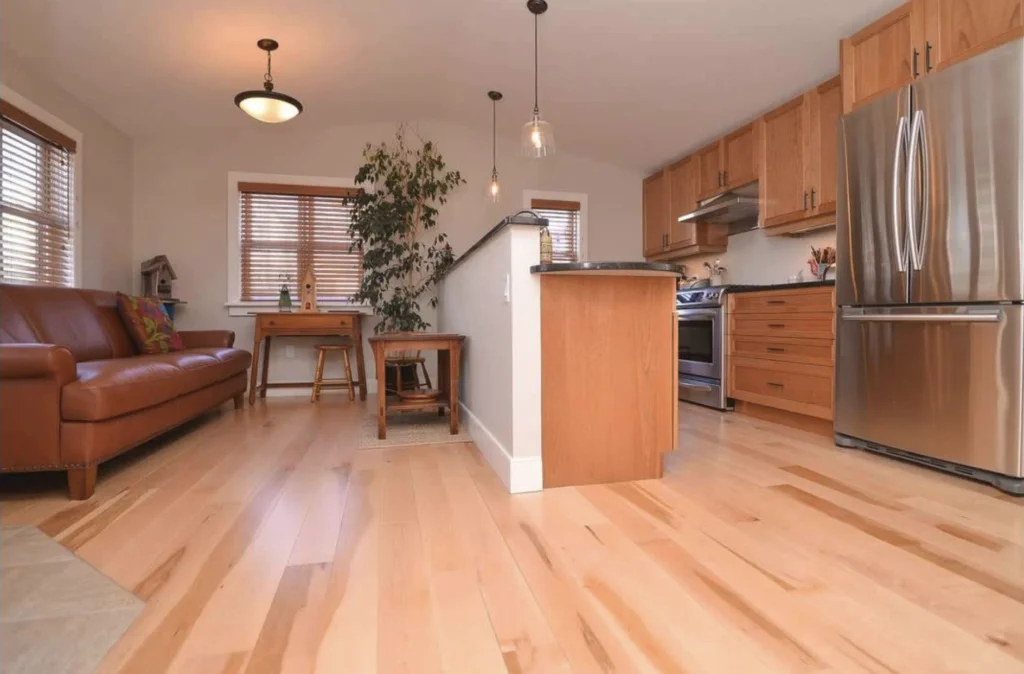Maple hardwood flooring offers a beautiful, durable option for those seeking a light-colored, fine-grained wood floor. Known for its density and resilience, maple is an excellent choice for modern, minimalist, and contemporary home designs. However, before committing to maple, there are various factors to evaluate to ensure it’s the right fit for your space and lifestyle. This guide will walk you through everything you need to know about maple hardwood flooring.
Maple hardwood flooring is a popular choice for homeowners who want to bring the elegance of natural wood into their interiors. With its creamy color, subtle grain, and durability, maple has become a staple in many modern and traditional homes. But is maple the best option for you? Here, we explore all the key details to help you make an informed decision.
What Maple Hardwood Flooring Is
Maple hardwood flooring is crafted from the wood of maple trees, primarily harvested in the northern United States and Canada. It’s a domestic hardwood known for its sustainability and eco-friendly qualities, as it is fast-growing and readily available. Maple’s light color and uniform appearance make it a top choice for sleek, modern interiors.
Types of Maple Hardwood Flooring

Solid Maple Flooring
Solid maple flooring consists of planks made from a single piece of maple wood. This type of flooring can be sanded and refinished multiple times, making it a long-lasting choice.
Engineered Maple Flooring
Engineered maple flooring is composed of a maple veneer on top of plywood or high-density fiberboard. It’s more resistant to humidity changes and is a good choice for below-grade installations or areas with higher moisture.
Pros and Cons of Maple Hardwood Flooring

Pros
- Hard and Dense: Maple’s hardness makes it resistant to wear and tear.
- Tight Grain: The grain pattern is smooth and uniform, adding to its modern appeal.
- Moderate Cost: It’s generally more affordable than exotic hardwoods.
- Eco-friendly: Maple is a sustainable option due to its domestic growth.
Cons
- Limited Stain Compatibility: Maple doesn’t take stains well, often leading to uneven results.
- Visible Scratches: Due to its smooth surface, scratches can be more noticeable.
- Fewer Color Options: Maple’s natural color limits customization.
- Humidity Sensitivity: Sharp humidity changes can cause maple to expand or contract.
Maple Flooring Characteristics
Hardness and Durability
Maple is one of the hardest domestic hardwoods, even harder than oak, making it an excellent choice for high-traffic areas.
Grain and Color
Maple has a very subtle grain pattern, with colors ranging from creamy white to light brown. This soft, natural appearance makes it ideal for minimalist interiors.
Ideal Rooms for Maple Hardwood Flooring
Due to its strength and smooth finish, maple is well-suited for living rooms, dining rooms, and bedrooms. However, it may not be the best choice for kitchens or bathrooms because of its susceptibility to humidity.
Installation Tips for Maple Hardwood Flooring
Maple flooring requires special care during installation to ensure it performs well over time. Here’s a look at some important installation tips.
Acclimation Before Installation
Maple should be acclimated to the room’s environment for 48 to 72 hours before installation. Unbox the planks and allow airflow around them to reduce the risk of warping or expansion.
How to Sand Maple Flooring Properly
Because maple is a dense wood, sanding can be challenging. Use a professional-grade sander at a low setting to avoid creating unwanted marks. Any mistakes during sanding are easily visible on maple.
Staining Maple Flooring
Maple’s natural light color doesn’t take stains well, often leading to an uneven finish. Let’s look at the two main options for staining maple floors:
Factory-Stained Maple
If you prefer a stained maple floor, consider pre-stained maple from the factory. These products have a more consistent stain application and color.
On-Site Staining
Staining maple on-site is generally not recommended due to its difficulty in achieving a uniform color. Many homeowners choose to leave maple natural and apply a clear coat for protection.
Cost of Maple Hardwood Flooring

The price of maple flooring varies depending on whether it’s solid or engineered, and whether it’s factory-stained or natural. Here’s a general cost breakdown:
- Natural Solid or Engineered Maple: $5–$8 per square foot
- Factory-Stained Maple: $8–$12 per square foot
Comparing Maple to Other Hardwood Flooring Options
Maple vs. Oak Flooring
Oak has a more pronounced grain and stains well, making it a versatile option for varied finishes. While softer than maple, oak’s grain hides scratches more effectively, making it better for high-traffic areas.
Maple vs. Ash Flooring
Ash resembles maple in color and texture but is not as hard or dense. Ash also accepts stains better than maple, allowing for more color variation.
Maintenance and Care Tips
Handling Scratches on Maple Floors
Since maple scratches more easily than some other woods, using rugs or runners in high-traffic areas can help protect the surface.
Humidity and Climate Control for Maple Flooring
Maple is sensitive to humidity changes, so using a humidifier or dehumidifier as needed will help maintain its shape and structure.
Conclusion
Maple hardwood flooring is a durable, stylish choice for many home interiors, especially those that favor a clean, minimalist look. While it has a range of benefits, like hardness and sustainability, it’s essential to consider its sensitivity to humidity and difficulty with staining. With proper care, maple can add a timeless elegance to your home that will last for years.
Frequently Asked Questions (FAQs)
Does maple hardwood flooring darken over time?
Yes, maple flooring can develop a slightly darker tone as it ages, giving it a more golden appearance.
Can maple hardwood be refinished?
Yes, both solid and engineered maple hardwood can be refinished, though solid maple allows for more refinishing cycles.
How should I clean maple hardwood flooring?
It’s best to use dry methods, such as sweeping or a dry mop. Avoid using excessive water, as maple is prone to moisture damage.
Is maple hardwood flooring pet-friendly?
Maple is a hard wood, making it scratch-resistant to a degree, but scratches from pet nails may still be visible.
What’s the difference between solid and engineered maple flooring?
Solid maple is a single piece of wood, while engineered maple has a top veneer layer of maple with a plywood or fiberboard core, offering better moisture resistance.
